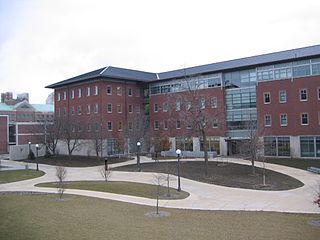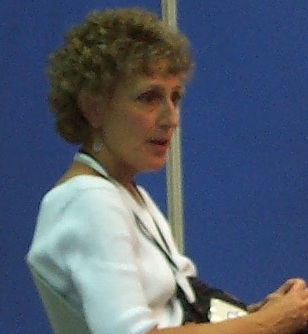Related Research Articles

The National Center for Supercomputing Applications (NCSA) is a state-federal partnership to develop and deploy national-scale cyberinfrastructure that advances research, science and engineering based in the United States. NCSA operates as a unit of the University of Illinois Urbana-Champaign, and provides high-performance computing resources to researchers across the country. Support for NCSA comes from the National Science Foundation, the state of Illinois, the University of Illinois, business and industry partners, and other federal agencies.

Scientific visualization is an interdisciplinary branch of science concerned with the visualization of scientific phenomena. It is also considered a subset of computer graphics, a branch of computer science. The purpose of scientific visualization is to graphically illustrate scientific data to enable scientists to understand, illustrate, and glean insight from their data. Research into how people read and misread various types of visualizations is helping to determine what types and features of visualizations are most understandable and effective in conveying information.

Lillian Feldman Schwartz was an American artist considered a pioneer of computer-mediated art and one of the first artists notable for basing almost her entire oeuvre on computational media. Many of her ground-breaking projects were done in the 1960s and 1970s, well before the desktop computer revolution made computer hardware and software widely available to artists.

Larry Lee Smarr is a physicist and leading pioneer in scientific computing, supercomputer applications, and Internet infrastructure. He is currently a Distinguished Professor Emeritus at the University of California, San Diego, and was the founding director of the California Institute for Telecommunications and Information Technology, as well as the Harry E. Gruber Endowed Chair Professor of Computer Science and Information Technologies at the Jacobs School of Engineering.
Thomas Albert "Tom" DeFanti is an American computer graphics researcher and pioneer. His work has ranged from early computer animation, to scientific visualization, virtual reality, and grid computing. He is a distinguished professor of Computer Science at the University of Illinois at Chicago, and a research scientist at the California Institute for Telecommunications and Information Technology (Calit2).
The Electronic Visualization Laboratory (EVL) is an interdisciplinary research lab and graduate studies program at the University of Illinois at Chicago, bringing together faculty, students and staff primarily from the Art and Computer Science departments of UIC. The primary areas of research are in computer graphics, visualization, virtual and augmented reality, advanced networking, and media art. Graduates of EVL either earn a Masters or Doctoral degree in Computer Science.

Patrick M. Hanrahan is an American computer graphics researcher, the Canon USA Professor of Computer Science and Electrical Engineering in the Computer Graphics Laboratory at Stanford University. His research focuses on rendering algorithms, graphics processing units, as well as scientific illustration and visualization. He has received numerous awards, including the 2019 Turing Award.
Edward Seidel is an American academic administrator and scientist serving as the president of the University of Wyoming since July 1, 2020. He previously served as the Vice President for Economic Development and Innovation for the University of Illinois System, as well as a Founder Professor in the Department of Physics and a professor in the Department of Astronomy at the University of Illinois at Urbana-Champaign. He was the director of the National Center for Supercomputing Applications at Illinois from 2014 to 2017.
Kevin Franklin, EdD was born in Virginia, where he received degrees in psychology and education from Old Dominion University. He holds a Doctorate of Education in organization and leadership from the University of San Francisco. Formerly executive director of the University of California system-wide Humanities Research Institute (UCHRI) and a deputy director of the San Diego Supercomputer Center (SDSC), Franklin was appointed as executive director of the Institute for Computing in Humanities, Arts, and Social Science, (I-CHASS), research professor, education policy, organization and leadership, adjunct associate professor, African American studies, and senior research scientist for the National Center for Supercomputing Applications at the University of Illinois in July 2007. In addition Franklin was appointed associate director for the National Center for Supercomputing Applications (NCSA) in 2014.
The Institute for Computing in Humanities, Arts, and Social Science (I-CHASS) at the University of Illinois at Urbana–Champaign was established in 2005 to conduct research at the intersection of high performance computing and humanities, arts, and social science. I-CHASS is hosted by the National Center for Supercomputing Applications (NCSA) and maintains strategic partnerships with NCSA, the Great Lakes Consortium for Petascale Computation (GLCPC), and the Illinois Informatics Institute (I3).

Maxine D. Brown is an American computer scientist and retired director of the Electronic Visualization Laboratory (EVL) at the University of Illinois at Chicago (UIC). Along with Tom DeFanti and Bruce McCormick, she co-edited the 1987 NSF report, Visualization in Scientific Computing, which defined the field of scientific visualization.
Maureen C. Stone is an American computer scientist, specializing in color modeling.

The University of Illinois Department of Computer Science is the academic department encompassing the discipline of computer science at the University of Illinois Urbana-Champaign. According to U.S. News & World Report, both its undergraduate and graduate programs rank in the top five among American universities, and according to Computer Science Open Rankings, the department ranks equally high in placing Ph.D. students in tenure-track positions at top universities and winning best paper awards. The department also ranks in the top two among all universities for faculty submissions to reputable journals and academic conferences, as determined by CSRankings.org. From before its official founding in 1964 to today, the department's faculty members and alumni have contributed to projects including the ORDVAC, PLATO, Mosaic, JavaScript and LLVM, and have founded companies including Siebel Systems, Netscape, Mozilla, PayPal, Yelp, YouTube, and Malwarebytes.
Tiffany Holmes is an American new media artist and educator. She is based in Chicago, Illinois.
Holly Rushmeier is an American computer scientist and is the John C. Malone Professor of Computer Science at Yale University. She is known for her contributions to the field of computer graphics.
Jane Veeder is an American digital artist, filmmaker and educator. She is a professor at San Francisco State University in the Department of Design and Industry, at which she held the position of chair between 2012 and 2015. Veeder is best known for her pioneering work in early computer graphics, however she has also worked extensively with traditional art forms such as painting, ceramics, theatre, and photography.

Ellen R. Sandor is an American new media artist. She is also founder of the Chicago-based (art)n, a collective of artists, scientists, mathematicians, and computer experts. Ellen Sandor and (art)n create sculptures that contain computer-generated photographic images that appear to be three dimensional. She is best known for combining computer graphics, sculpture, and photography to visualize subject matter that includes architecture, historical events, and scientific phenomena such as the AIDS virus, Neutrinos, Microglia, and CRISPR.
Barbara Sykes into a family of artists, designers and inventors. Since childhood, she has produced work in a variety of different art forms. In 1974, she became one of Chicago's pioneering video and new media artists and, later to include, independent video producer, exhibition curator and teacher. Sykes is a Chicago based experimental video artist who explores themes of spirituality, ritual and indigeneity from a feminist perspective. Sykes is known for her pioneering experimentation with computer graphics in her video work, utilizing the Electronic Visualization Laboratory at the University of Illinois, Chicago, at a time when this technology was just emerging. Her early works broke new grounds in Chicago's emerging New Media Art scene, and continue to inspire women to explore experimental realms. With a passion for community, she fostered significant collaborations with many institutions that include but are not limited to University of Illinois, School of the Art Institute of Chicago, Columbia College, Center for New Television, and (art)n laboratory. These collaborations became exemplary for the showcasing of new media work. The wave of video, new media and computer art that she pioneered alongside many other seminal early Chicago New Media artists persists as a major influence for artists and educators today. Her work has been exhibited internationally, at institutions such as Moderna Museet (Stockholm), Ny Carlsberg Glyptotek (Copenhagen), Musée d'Art Moderne de la Ville de Paris, Museum of Contemporary Art San Diego, Metropolitan Museum of Art , Museum of the Art Institute (Chicago), The Metropolitan Museum of Art and SIGGRAPH. Sykes's tapes have been broadcast in Sweden, Italy, Puerto Rico and extensively throughout in the US, including "The Independents", PBS national broadcast, 1985, and national cablecast, 1984. Media Burn has an online selection of her tapes and over 200 of her raw footage, master edits, dubs and compilation tapes in their Independent Video Archives @ Barbara Sykes https://mediaburn.org/collections/videomakers-page/barbara-sykes/. Select grants include a National Endowment for the Arts and American Film Institute Regional Fellowship, Evanston Art Council Cultural Arts Fund and several Illinois Arts Council grants. In 2017, Sykes began to paint. In 2020, as the recipient of an Evanston Art Center Individual Artist Exhibition Award, Ethereal Abstractions, Sykes's first solo watercolor exhibition premiered 81paintings and she gave an online Artist Talk. Her paintings are lyrical, colorful abstractions reminiscent of organic shapes, ethereal forms and underwater landscapes - evocative impressions of spiritual and elemental worlds. They evoke the spontaneity and themes that have evolved from her previous body of time-based and digital artwork. In 2021, she moved to Florida. Her 2022 painting exhibitions/reviews include Forces of Nature showcased on the cover of Estero Life Magazine and she is in the article, Beholding Beauty: Artists of Estero Exhibit at COCO Art Gallery, the Florida Watercolor Society's 2022 Online Show, the 36th Annual All Florida Exhibition and Connections Art in Flight exhibit at the Southwest Florida International Airport, June 2022 to June 2023. She paints under the name of Barbara L. Sykes.
The Advanced Visualization Lab (AVL) is a team at the National Center for Supercomputing Applications at the University of Illinois at Urbana-Champaign. The AVL specializes in creating cinematic scientific visualizations of large, three-dimensional, time-evolving data. The AVL has contributed to a number of scientific documentaries including the IMAX films "A Beautiful Planet". and "Hubble 3D", a number of fulldome films, and television documentaries.
Cinematic scientific visualization (CSV) is the visual presentation of scientific data in a way that is typically associated with non-scientific filmmaking techniques including cinematography, lighting, and composition. Cinematic scientific visualizations are often created for purposes of science communication to the general public, e.g. through museum exhibits and documentary films. CSV is considered a subfield of scientific visualization, although the creation methods and visual outputs differ due to CSV's heavy emphasis on aesthetics and design.
References
- ↑ Donna J. Cox Archived 2016-10-17 at the Wayback Machine at intellectbooks.co.uk. Retrieved 10 July 2008.
- 1 2 Professor Donna J. Cox. Abbreviated Vita, Last update September 2006. Retrieved 10 July 2008.
- ↑ NCSA's Donna Cox receives first Michael Aiken Endowed Chair released 03.10.08. Retrieved 10 July 2008.
- ↑ "$1.5 million grant to NCSA to put big data on big screen". www.news-gazette.com. 11 November 2014. Retrieved 2016-03-05.
- ↑ "The National Center for Supercomputing Applications at the University of Illinois at Urbana-Champaign". www.ncsa.illinois.edu. 6 November 2014. Retrieved 2016-03-05.
- ↑ "2019 Distinguished Artist Award for Lifetime Achievement in Digital Art: Donna Cox". ACM SIGGRAPH. Retrieved 2019-08-14.
- ↑ "NCSA Access:Cosmic Voyage Nominated for Academy Award". Archived from the original on 2016-10-17. Retrieved 2016-10-01.
- ↑ "National Center for Supercomputing Applications at the University of Illinois". www.ncsa.illinois.edu. Archived from the original on 2014-02-18.
- ↑ "Working Hollywood: Creating the universe for 'The Tree of Life'". 25 February 2012.
- ↑ "The Demo 2014-2015 Touring Prospectus" (PDF).
- ↑ Animation (September 30, 2005). "Put These On Your List Too!". Animation.